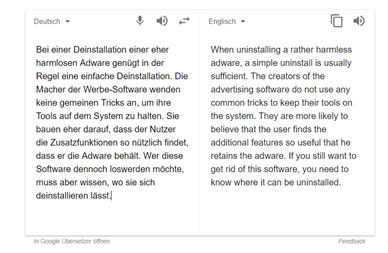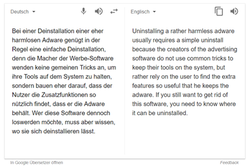
One of the tenets that most proponents of an easily comprehensible style of writing seem to agree on is that
sentences should not be too long.
The Plain English Campaign, for example, recommends that clear writing should have an average sentence length of 15 to 20 words. Complex sentences can cause havoc because the structure and meaning may not be clear.
Let’s put a machine to the test. The following German example (in box on right) contains four short sentences.
As you can see, Google Translate is quite capable of delivering a correct English version that makes perfect sense.
What happens if we turn three of those sentences into one long ‘snake’ of a sentence? Let’s add some conjunctions:
…eine einfache Deinstallation, denn die Macher…, sondern bauen eher darauf…
Again, the result is satisfying:

Note how the program even offers a bit of stylistic variation by differentiating between “are likely to believe” and “rely on”.
So why do blunders and howlers still occur? Any idea? And why is the following sentence (from the AWS website) not perfect? (Clue: it has to do with the translation of ‘simply’.)
Wenn Ihr kostenloser Nutzungszeitraum abgelaufen ist oder Ihre Nutzung das Kontingent übersteigt, zahlen Sie einfach die üblichen nutzungsbasierten Preise.
Send me your answers and let’s start the discussion. Alternatively, come back in a few weeks’ time when we’ll take the topic further to talk about nominalizations, semantics (vocabulary) and the role of punctuation in machine translation. And on how to avoid losing vital bits of information. See you then!
References:
Duden-Ratgeber Technische Dokumentation. Beschreibende und anleitende Texte erstellen. 2012. (von Andreas Schlenkhoff in Zusammenarbeit mit der Duden-Redaktion) ISNB: 978-3-411-74721-4
Martin Cutts. 1996. The Plain English Guide. How to write clearly and communicate better. ISNB: 0-19-860049-6



 RSS Feed
RSS Feed